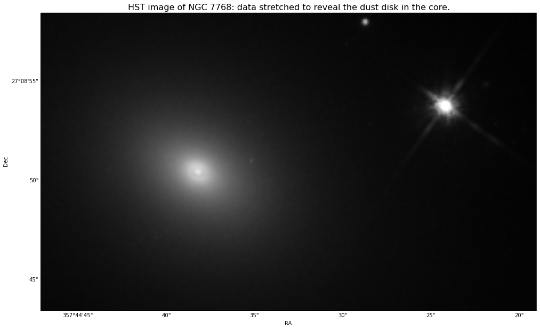November 2016 - Galaxy of the Month
Abell 2666 in Pegasus
This interactive image of the Abell 2666 group was provided by the Sloan Digital Sky Survey using Aladin Sky Atlas. We also have a finder chart should help you locate these galaxies.
Located just inside the square of Pegasus the galaxy cluster AGC 2666 is often overlooked by observers. It appears in neither the Night Sky Observers Guide (NSOG) or L&S which is perhaps rather surprising. It even does not make the Webb Deep-Sky Society Observer's Handbook (WDSSOH) Vol. 5! Despite this it seems to be quite a common imaging target.
The main galaxies in the group lie along a line anchored on the giant cD galaxy NGC 7768. At around 12th magnitude NGC 7768 was discovered by John Herschel in 1828, but the other three NGC galaxies in the group are much fainter and were discovered by Lord Rosse and his assistants using the 72” reflector at Birr. These are NGC 7765, 7766 and 7767 and they come in at around 14th magnitude. There are also a number of non NGC galaxies in the chain at around the same magnitude. As such I think this cluster will be a target for larger telescopes.
With the exception of NGC 7768 the brighter members of the group appear to be disproportionally spiral galaxies. NGC 7768 has a number of interesting properties and as well as having a supermassive black hole at its centre it has far fewer globular clusters than might be expected for a galaxy of its size and location. Hubble did observe the galaxy and the image can be retrieved from the Hubble Legacy Archive but the original is not too interesting. Properly stretched however the centre of the galaxy does show a dust disk, unusual for this type of galaxy.

A number of the galaxies in the cluster show signs of interactions but perhaps the most interesting is the galaxy labelled as MCG 4-56-14 in the accompanying chart. It shows signs of an enormous plume on deep images extending from its spiral arm, not unlike the more famous atoms for peace galaxy NGC 7252. It is almost certainly the remnant of a recent merger. One of the best amateur images can be found on the Rancho Del Sol Observatory website. Even the SDSS image does not show the plume well. MCG 4-56-14 is also a LINER galaxy, an active galaxy with emission lines from an AGN. Note that as always what name a galaxy is given tends to be at the choice of the article writer so MCG 4-56-14 is also referenced as CGCG 477-016 in some articles.
NED suggests the diameter of the group is of the order of 50 arcmins but the main core is much smaller than that, with the main line perhaps 13 arcmin in length. The group lies at a distance of about 112 Mpc which gives it an Abell distance classification of 1 (where 0 is the closest). There are some very blue objects in the SDSS image which appear to be foreground sdO stars.
Owen Brazell - Galaxy Section Director